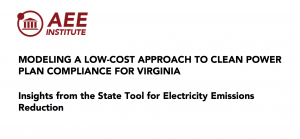Blog: New White Paper – Clean Power Plan can have minimal impact on Virignia ratepayers, and energy efficiency is key
January 20, 2016
“Implementing the U.S. Environmental Protection Agency’s Clean Power Plan would have minimal impact on electricity costs in Virginia, and could even provide savings for ratepayers under some scenarios, compared with projected energy costs in 2030.” Those are among the findings of a white paper released today by the Advanced Energy Economy Institute.
The basis of the paper is an open-access analytic tool called the State Tool for Electricity Emissions Reduction (STEER) that allows state officials and other stakeholders to consider CPP compliance options and their economic impacts.The paper presents the results of two specific scenarios that are representative of multiple runs through STEER.
Echoing previous regional and national studies, this report emphasizes the important role energy efficiency can play in meeting CPP carbon reduction targets:
“Over several runs of the STEER model, energy efficiency and renewable energy are consistently the lowest cost mitigation options for the state. With significant energy efficiency potential, the state has an untapped resource in utility energy efficiency and network efficiency improvements.”
 Most likely to turn heads is the report’s finding that with energy efficiency and renewables, these targets can be with minimal impact on electricity costs in Virginia compared with business as usual:
Most likely to turn heads is the report’s finding that with energy efficiency and renewables, these targets can be with minimal impact on electricity costs in Virginia compared with business as usual:
“In Scenario A there is a minor rate increase seen, less than a half of a penny per kilowatt hour, compared with a business-as-usual projection. In Scenario B, the scenario using the SCC’s efficiency potential study, we see a decrease in electric rates compared with business-as-usual. In neither scenario do we see significant costs imposed on Virginia ratepayers as a result of Clean Power Plan compliance. The result is likely due to the substantial contribution to compliance made by low-cost resources such as energy efficiency and renewable energy. The scenarios shown here demonstrate that Virginia can achieve its required carbon reduction targets without imposing significant costs on ratepayers compared with business as usual.”
As the Commonwealth moves forward with CPP compliance plans, reports of this nature provide state leaders with another layer of evidence that the targets are achievable when we harness energy efficiency and renewables.
Side note: The American Council for an Energy Efficient Economy (ACEEE) just released the State Utility Pollution Reduction Calculator Version 2 (SUPR2), a tool that allows anyone to explore the cost and pollution reduction potential of different strategies.
Find out more and get access to ACEEE’s SUPR2 here.
Read the full Advanced Energy Economy Institute white paper here. The press release is also available here.
STEER for VIRGINIA is available for download as an Excel spreadsheet, with user manual, at http://info.aee.net/steer-virginia.
